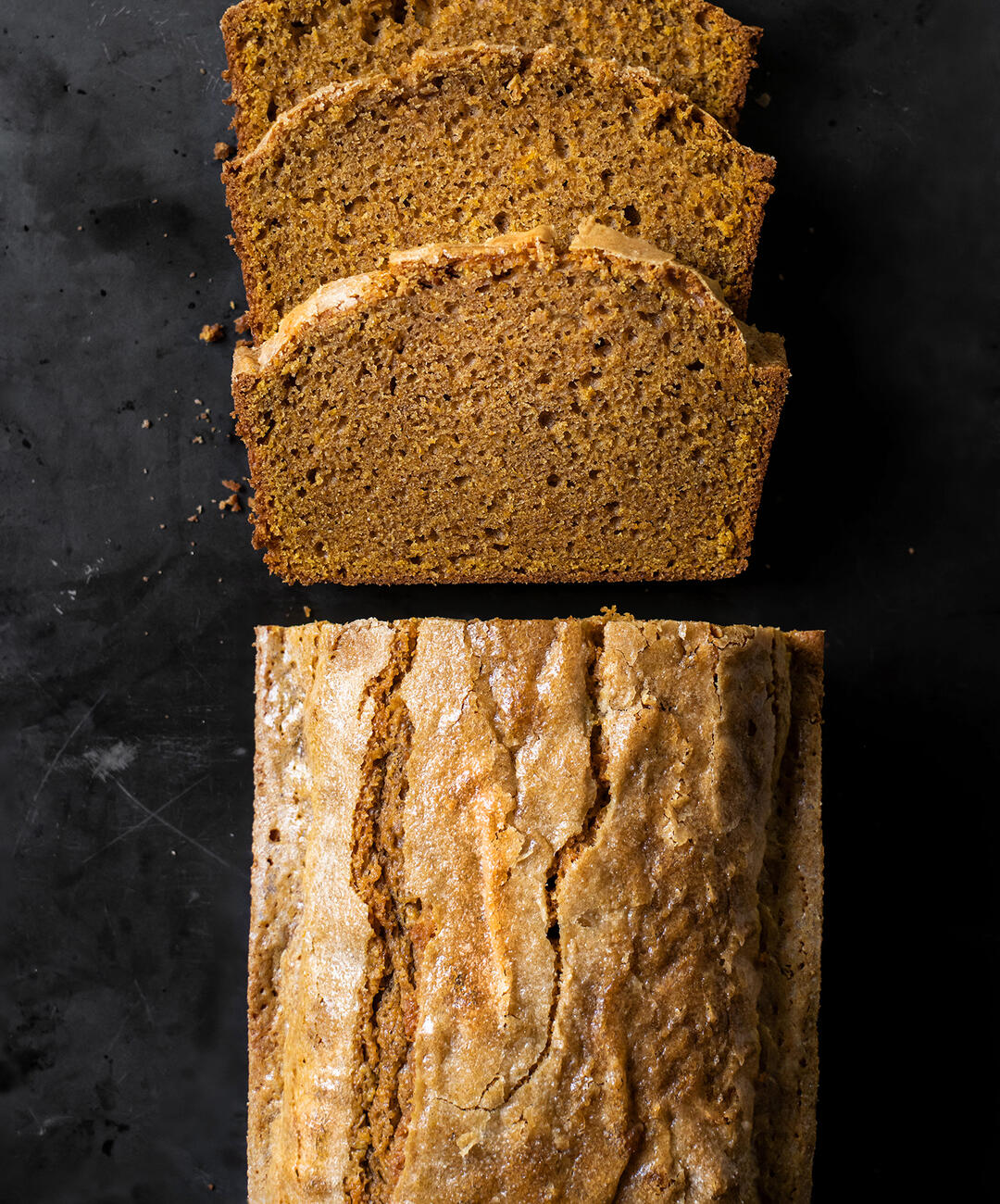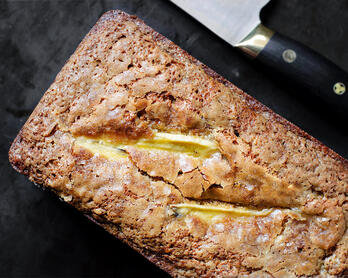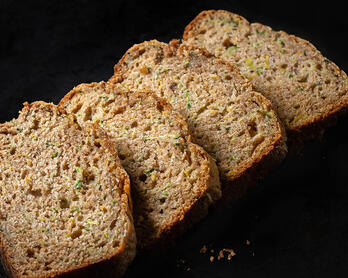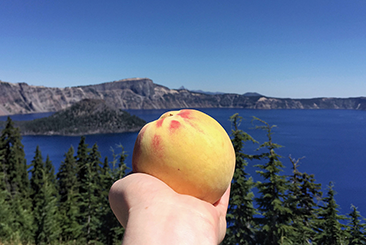Tartine Bakery's Pumpkin Tea Cake

This post has been updated with new images and expanded notes.
Since originally publishing Tartine's Pumpkin Tea Cake, my approach to baking has changed in that I usually substitute at least 20% whole grains when all-purpose flour is called for. It's not a health thing, quality whole grains just taste better. For this gently adapted version of Elisabeth Prueitt's already excellent Pumpkin Bread, I subbed roasted butternut squash for canned pumpkin in addition to using 20% Grist & Toll spelt. This updated tea cake has an added depth of flavor that is outstanding and the texture is just right. Roasted squash freezes beautifully so you can squirrel a big batch away for all of your fall baking needs. x
With all of the above being said, don't hesitate to use white flour and canned pumpkin if that's what you have on hand. The original recipe is on just about every "best of" list so you won't be disappointed. Instructions for all options plus additional notes and visual cues included below. This recipe is also very dependable - you almost can't tell the photos are of two different bakes.
Cookbook note...
The Pumpkin Tea Cake recipe in Tartine Revisited and the original Tartine cookbook are essentially the same. There are however enough differences between the two books that I'm inclined to suggest bakers have both. For example, the croissant recipe in Tartine has never failed me and differs from Tartine Revisited. My understanding per Liz Prueitt is that the first Tartine - a classic - is going out of print so get your copy while supplies last. The layout is clean, well organized, both volume and weight measurements are offered, and the "kitchen tips" at the start of each recipe are spot on. Not an ad, just a fanwoman.
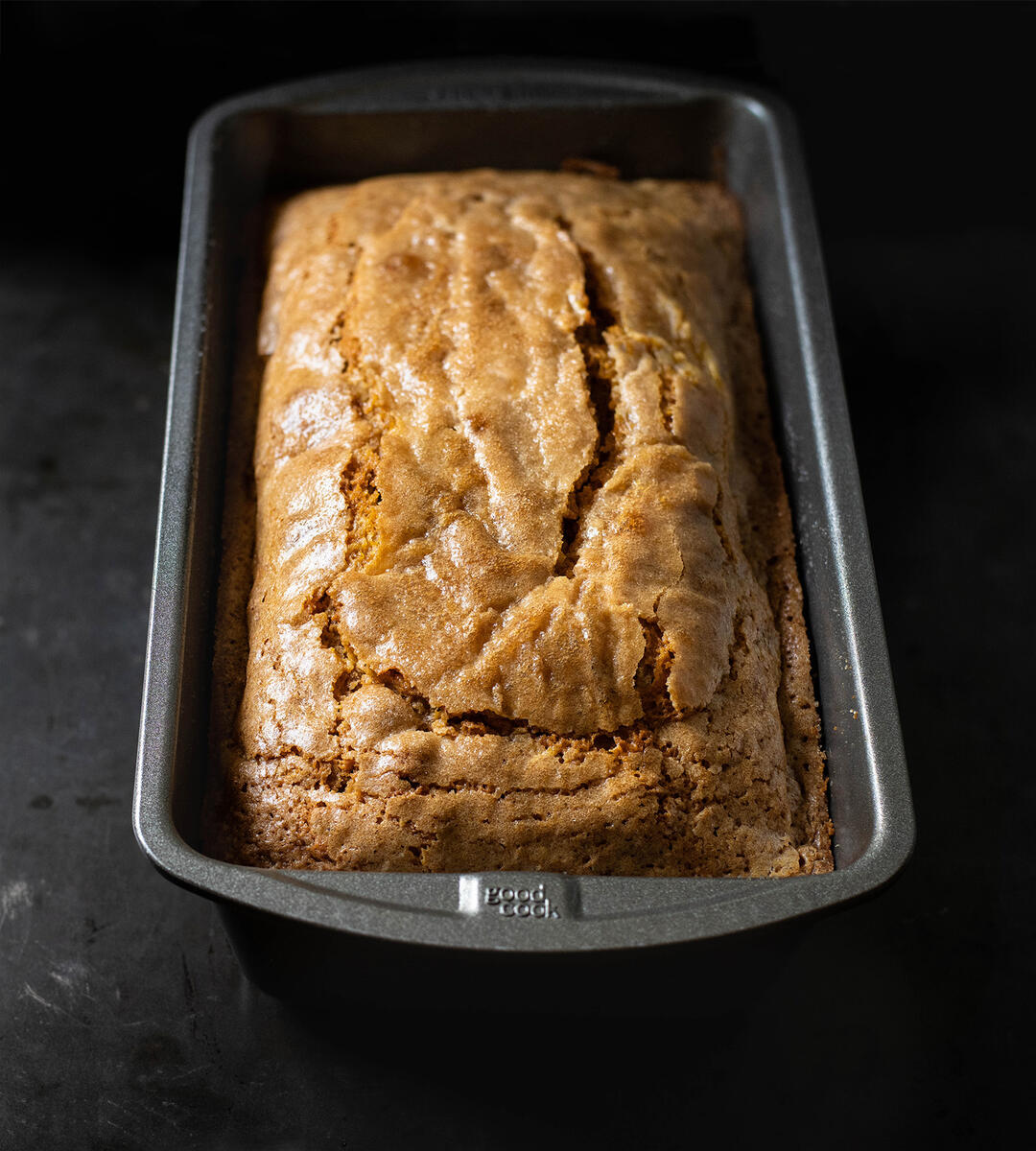
Original vs. Adapted
Sweet Stuff
- When using roasted squash, I reduce the batter's sugar by 15 grams. With canned purée I go with the original amount as per the cookbook. Quantity options included under "Ingredients".
- I reduce the topping sugar from 2 tablespoons to 1 tablespoon irrespective of what kind of purée I am using.
Spice and Everything Nice
- The original recipe calls for 5 teaspoons of cinnamon. After some tweaking, I settled on 4 1/2 teaspoons and am happy with the results.
Recipe Tips
Mise en Place
- All of the ingredients should be measured and at room temperature (65-70°F or thereabouts ) before mixing begins. On the measuring note, using a scale is the best way to bake if you want consistent results.
Overmixing
- The batter needs very little mixing when incorporating the flour. Be sure not to overdo it or the crumb may toughen up.
Egg Size
- The size of farmer market eggs varies widely. I let the eggs come up to room temperature in the shell, then crack them into a spouted measuring cup and measure the weight. You want approximately 150 grams for 3 eggs. My impression is that most baking recipes assume 50 grams per egg (out of the shell).
Moisture
- When using fresh squash for pumpkin tea cake, pumpkin pie, or Kabocha Olive Oil & Bittersweet Chocolate Cake, the key is to extract enough moisture during the roasting process. All of the before and after weights are included under "Instructions". I recommend relying on your scale rather than the roasting time.
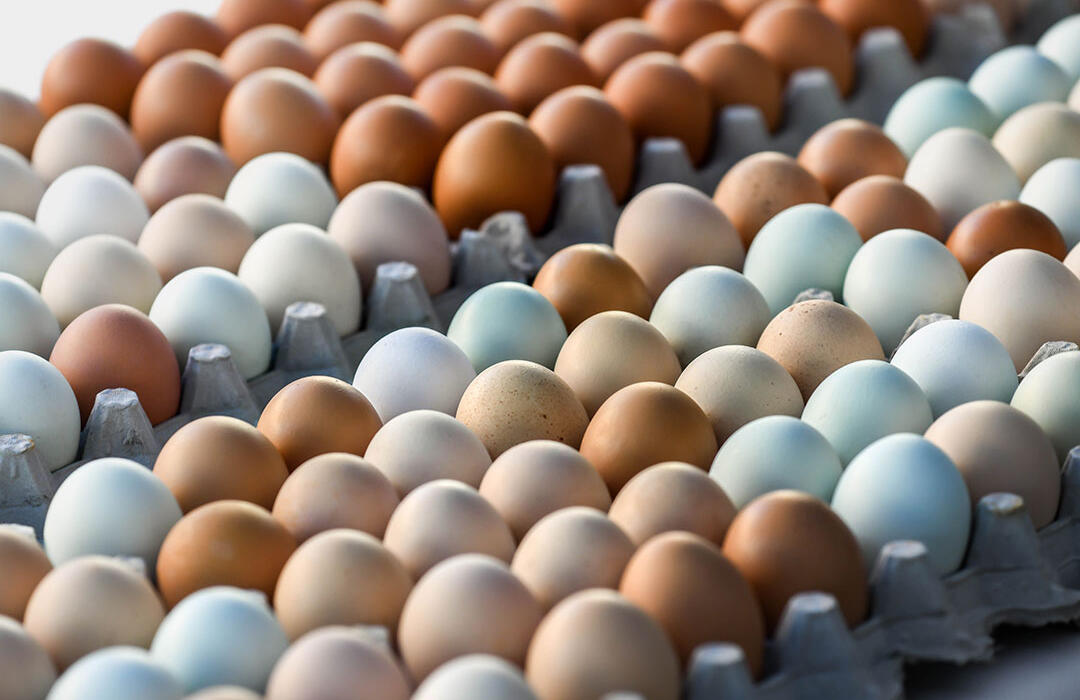
Eggs at Omma's Garden - Santa Monica Farmers Market
Farmers | Artisans
I make an effort to source my food from California artisans with a special focus on the Santa Monica Farmers Market. Below is a list of the folks who contributed to this dish.
- Central Milling / Organic Beehive All-Purpose Flour
- Grist & Toll / Whole Grain Spelt Flour
- Windrose Farm & The Garden Of... / Butternut Squash
- Omma's Garden / Eggs
Tools
- Digital Thermometer - I own three Thermapen digital thermometers and have distributed them between my home, the Airstream, and my mother-in-law's house. They're nimble, easy to clean, and the probe is the perfect cake tester. I reach for it often.
- OXO Scale - Have you hugged your scale today? Generally speaking, it's good practice to use a scale when baking. There are two in my kitchen, the workhorse being an OXO model that I purchased over 10 years ago and only recently had to replace. RIP scale #1. It's a sturdy cooking companion that repeatedly gets covered in flour, sauce, or whatever else is flying around the kitchen.
- Fine Mesh Strainer (for sifting)
- No-slip Bowl - My primary mixing bowl. The silicone bottom holds the bowl steady while you whisk which is very helpful.
- Loaf Pan - Famously featured here, here, and here.
- Whisk - I own this brand of whisks in a few different sizes.
- Rubber Spatula
- Baking Sheet
- Cooling Rack
- Aluminum Foil
- Parchment Paper
Ingredients (Adapted from Tartine)
- 1 1/3 cups (6 1/2 ounces/180 grams) Central Milling Organic Beehive all-purpose flour
- 1/3 cup (1 1/2 ounces/45 grams) Grist & Toll whole grain spelt flour Note: All-purpose flour can be substituted.
- 1 1/2 teaspoons baking powder
- 1/2 teaspoon baking soda
- 4 1/2 teaspoons ground cinnamon
- 2 teaspoons freshly ground nutmeg
- 1/4 teaspoon ground cloves
- Pumpkin Option 1 9 1/4 ounces roasted butternut squash purée from a 2-pound squash - steps under "Instructions"
- Pumpkin Option 2 9 1/4 ounces canned pumpkin purée (measured before removing any moisture - steps under "Instructions")
- 1 cup (7 ounces/200 grams) vegetable oil such as safflower or sunflower Note: I use almond oil.
- 1 cup + 1/4 tablespoons (255 grams) granulated sugar Note: If using canned pumpkin, I recommend the original amount of sugar which is 1 1/3 cups (9 1/2 ounces/270 grams).
- 3/4 teaspoon Diamond kosher salt
- 3 large eggs, room temperature Note: My post about eggs and why they should be room temperature is here.
- 1 tbsp granulated sugar for topping
Instructions
Pumpkin Purée
Option 1- Roasted
- Move oven rack to the middle position and pre-heat to 375°F.
- Line a baking sheet with foil and then lay a piece of parchment paper on top of that.
- Peel the butternut squash and then cut into 1 to 1 1/2-inch cubes. Trim off and discard any webbing or seeds. You should end up with approximately 1 1/4-1 1/2 pounds.
- Transfer the squash cubes to the baking sheet and toss with 1 tablespoon of olive oil and sprinkle with a pinch of kosher salt.
- Roast for 50 to 70 minutes, tossing the squash and rotating the pan twice.
- The squash will caramelize a little which is fine. The final weight should be approximately 52% of what you started with, so 1 1/2 pounds (24 ounces) yields approximately 3/4 pound (12 1/2 ounces). You will only need 9 ounces for the recipe.
- This is the point at which you can stop and refrigerate the squash in an airtight container for 2-3 days.
Option 2 - Canned
The Tartine recipe doesn't call for it, but I reduced the moisture of the purée slightly by using the following method from Cook's Illustrated's pumpkin cheesecake. The resulting bread was very moist so I was glad to have taken this step. For what it's worth, I used Farmer's Market Organic Pumpkin.
- Put a piece of aluminum foil on the counter (for easy cleaning).
- Lay 3 paper towels on top of the foil, then spread your purée out on the paper towels so it's about an inch thick.
- Cover with 3 more paper towels and pat until soaked.
- Lift one side of the bottom paper towels, fold the purée in half (it will peel off on its own), then move it to a new set of paper towels.
- Repeat once or twice.
Mise en Place
Measure out all of the ingredients and let anything that was in the refrigerator come up to room temperature (65-70°F or thereabouts).
Mix
- Move oven rack to the middle position and preheat to 325°F.
- Lightly butter a 9x5 inch loaf pan. Cut a piece of parchment to fit the bottom and place that inside. Set pan aside.
- Whisk together the flour, baking powder, baking soda, cinnamon, nutmeg, and cloves then sift the mixture. Note: If using whole grains, dump any bran flakes back into the pile and whisk to recombine.
- In a no-slip bowl, add the oil, pumpkin purée, sugar, and salt. Whisk thoroughly then set aside for a few minutes. Whisk again. The texture should be cohesive and will plop rather than drizzle.
- Assuming your eggs are in a measuring cup as mentioned under "Recipe Tips", add 1/3 of the eggs and whisk until incorporated. Repeat two more times.
- Add half of the flour and whisk until 75% combined. Note: Overmixing this batter can lead to a tough crumb.
- Add the second half of the flour and whisk until just about combined. Switch to a rubber spatula, scrape down the sides and bottom of the bowl, then fold the mixture until fully combined. Note: If the batter looks lumpy it's probably just air bubbles. I almost kept mixing but then used my hand to feel the texture. Sure enough it was smooth.
- Lift the bowl and give it a few firm knocks on the counter to kick out the air bubbles.
Bake
- Scrape the batter into your prepared pan (it should be thick), smooth the surface, then sprinkle 1 tablespoon of granulated sugar evenly over the top.
- Place in the oven and set one timer for 30 minutes and a second timer for 60 minutes. Rotate the pan 180° at 30 minutes. Note: The characteristic cracks will be forming around the edge at the 30-minute mark.
- Bake for about an hour (my oven takes 65 minutes) until the internal temperature measured in the center is around 205°F. The reading will be higher closer to the edge of the tea cake. The Thermapen functions as both a digital thermometer and cake tester which is helpful. Note: When measuring the center, I've noticed that the cake tester isn't completely clean even when the internal temperature is 200-205°F. The edges however test clean at this point. Everything seems to sort itself out during the 20-minute rest.
- Remove the pan from the oven, gently run a paring knife between the tea cake and pan to ensure nothing sticks, then set the pan on a wire rack to cool for 20 minutes.
- After 20 minutes, carefully invert the pan (taking care not to destroy your crust) and peel off the parchment. Place the pumpkin bread on a wire rack. Let it cool completely before slicing.
Storage
Tartine recommends wrapping the bread in plastic. I prefer to put the cooled bread in a plastic bag or airtight container and store it at room temperature. The flavor and texture are even better on day 2. I give the tea cake slice a 5-6 second spin in the microwave after day 2.
